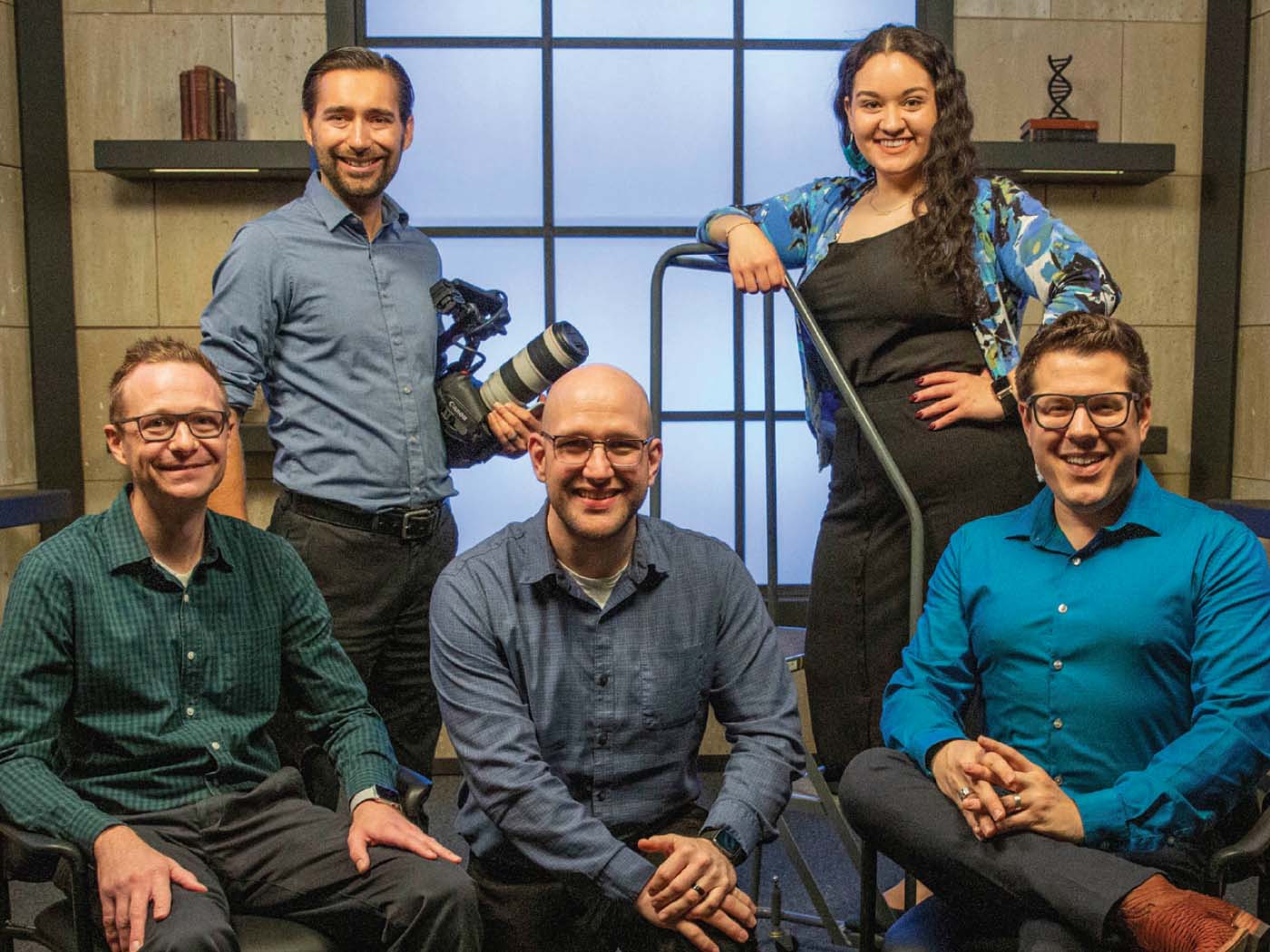A map is crucial for all travelers, from fun-seeking vacationers to serious scientific researchers. This month’s article is a map of the Engineered Adaptability series and highlights the places future articles will stop en route to its destination—a design-based framework that explains adaptability. To keep everyone traveling together, the articles will decipher information from peer-reviewed forums and supply an orientation so readers know where they’re headed.
Where Adaptability Goes, Evolutionary Theory Follows
Adaptability is a characteristic of all living things. If organisms couldn’t adapt to changing environments, then evolutionary theory would have nothing to work with. Evolutionists struggle to explain how adaptability could emerge since a creature cannot adapt until it is already adaptable. Evolution assumes that adaptability mysteriously arose through random genetic mutations that somehow proved advantageous. Evolutionary theory offers a naturalistic explanation for the origin of life’s diversity. It holds that changing environments—through their cycles of death and survival “acting” on adaptable organisms—are sufficient to slowly transform organisms into wholly different kinds of creatures.
In evolution’s quest to explain survival of the fittest, it has no viable explanation for the arrival of the fittest, as the saying goes. Thus, understanding adaptability is important not only in debunking evolution, but also in validating a creation model that proposes organisms are designed with a myriad of complex mechanisms that allow them to adapt. But how should creationist research into adaptability proceed?
Scientific activities take place within a structure of ideas and assumptions that define a field of study. Stephen Jay Gould’s purpose for writing his magnum opus, The Structure of Evolutionary Theory, wasn’t to provide evidence for evolution. Instead, its intent was to frame the history of scholarly exchanges that approved certain ideas and endorsed specific assumptions that became the evolutionary context used to interpret natural phenomena. Gould also noted how a theory’s structure establishes and prioritizes research programs, of which he said, “The best strategy, Darwin asserts, lies in the study of adaptation….The adaptations of organisms therefore constitute the bread and butter objects of study in evolutionary biology.”1
In scientific research, structures and frameworks are configurations of ideas explaining complex phenomena in the development of a theory. But an equally important way to describe a theory is like a map that sets the starting point and direction of travel toward a destination called “truthful explanations” in the realm of natural phenomena. The importance of underpinning theory with sound fundamental ideas is obvious. If the ideas and assumptions are wrong, then researchers start off in the wrong direction and are unlikely to get to truthful explanations.
Those who oppose evolutionary theory often point out its flawed ideas and assumptions but don’t offer a different structure for research. What would be useful, then, is an alternative framework for approaching biology that fundamentally contrasts with evolutionary mechanisms. Starting with one based on engineering principles, research may be guided to produce truthful explanations. Toward that end, the Engineered Adaptability series proposes a new framework:
The engineering principles that underlie how human-designed things self-adjust to changing environments is the most expedient way to explain how organisms adapt.
A Design-Based Theory of Adaptability
We don’t have a Structure of Design Theory book as a counterpart to Gould’s work. Design-promoting concepts have advanced primarily by 1) detailing the total insufficiency of the Darwinian mechanism; 2) exposing colossal hurdles for evolution such as the Cambrian Explosion; 3) highlighting many characteristics of organisms, especially their information content, that indicate the work of an intelligent agent; and 4) charting a rational approach for making a plausible inference to design. But while it is valuable, this work isn’t a clearly focused design-based structure for explaining adaptability.
Dr. David Snoke of the University of Pittsburgh has laid important groundwork for Intelligent Design advocates to utilize engineering principles to guide research via systems biology.2 His work is a section within the foundation of design theory.
One goal for this Engineered Adaptability series is to lay additional foundation. Several articles begin by replacing evolution’s outdated principal mechanism with a fresh, engineering-based approach to adaptability that incorporates the latest biological discoveries. One premise is that the engineering paradigm in modern biology is fundamental and engineering principles should therefore guide biological research.3 Humans design adaptable machinery and systems by invariably including internal features that control the entity’s relationship to environments. Hence, a structure of design theory could use engineering principles to more accurately interpret findings about biological functions within the context of a living creature’s innate systems.
Research, Interpretation, Causation: Why Starting Points Matter
Now is an excellent time for developing a new engineering-based theory. Next month’s article will show how evolutionary biologists are increasingly divided over theory. A recent conference—New Trends in Evolutionary Biology: Biological, Philosophical and Social Science Perspectives—deliberated if evolutionary theory needs to be extended or even renovated to accommodate fresh discoveries highlighting the incredible complexity of living systems and the severe problems they propose for evolution. One key organizer, Kevin Laland of the University of St. Andrews, noted that “the discussion witnessed little meeting of minds.”4 Previously, an article in the science journal Nature presented contrasting opinions on the question “Does evolutionary theory need a rethink?” The article noted that “researchers are divided over what processes should be considered fundamental.”5 Why the sharp division amongst evolutionists this late in the game? The answer spins on whether evolutionary theory’s ideas and assumptions set the correct starting point and direction for research.
Recent debates are plowing all the way back through evolutionary literature to how Darwin initially adopted the environment-dominant view of adaptation. He decided to explain adaptation “externalistically.” Darwin’s view perceives organisms as passive modeling clay whose basic form is molded over time by their environments.6 Form is imposed on organisms from without. Environments sculpt them into nature’s diverse forms. The organism-as-modeling-clay is the status quo assumption. It shapes the interpretation of results from studies focused on where the key action takes place—the organism-environment relationship.
The recent struggle in the evolutionary camp over fundamental processes revolves around discoveries of pervasive and complex internal mechanisms that organisms utilize to self-adjust to changing conditions.7 Per one New Trends conference attendee, this observation-to-theory mismatch is leading to “deeply entangled” causal explanations.8 Biochemist Michael Denton notes that tensions rise because “it is inconceivable to most English-speaking biologists that living things might contain a significant degree of order that arises from basic internal physical constraints,” an idea that many find “very alien” to their way of thinking.9
The evolutionists’ current uncertainty over how new discoveries fit their theory provides a rare opening for non-evolutionists to frame these data into a novel theory that does not incorporate evolutionary explanations.
A Theory That Integrates Engineering Causation and Principles
Scientific literature describes dozens of fascinating systems within creatures that control flexible expressions of problem-solving traits. The next stop in this series will describe a revived interest in a model called structuralism (a type of internalism) to explain new discoveries.
Yet, renewed interest in structuralism itself still misses the target. It is better to organize findings into an organism-focused, design-based theory of adaptability. Researchers who are open to considering that organisms may be designed could formulate theory that allows them to assume that organisms’ diverse systems have some discoverable purpose(s) and that those systems operate according to engineering principles.
For instance, what if a design-based research program was launched to investigate whether the same principles that regulate functions in human-designed vehicles also operate in creatures that travel through diverse environments? For human-engineered vehicles, intrinsic design controls detect challenging exposures and dictate specific measures as solutions. Per design-based theory, a similar innate self-adjusting capacity would be predicted within organisms. That is, organisms over multiple generations could actively detect environmental conditions, and innate systems could control the expression of a spectrum of traits (phenotypes) from a relatively stable set of instructions in the genome. A design-based theory might be able to help refine the full extent of internal control.
Throughout this series, we will focus on engineering causation. It’s different from philosophical, psychological, theological, or other causation. Objectivity is its distinguishing characteristic. Only verifiable elements are included in causal chains. In our series articles, these chains generally link genetics or epigenetic information through specific cellular systems to modified traits and then to the specific environmental conditions they relate to.
Continuous Environmental Tracking: An Engineered Means to Fill Niches
If engineering-minded scientists hypothesized how creatures spread into diverse niches (and possibly undergo speciation), they might produce a treatise titled On the Origin of Species by Means of Continuous Environmental Tracking. It’s not enough to just identify design features in systems. Those features should be fitted into some conceptual framework. Thus, the bulk of this series will highlight mechanisms through which organisms express traits that enable them to closely track changing conditions and adjust accordingly. This explanation for adaptability was given the descriptive title Continuous Environmental Tracking (CET) and was presented at several science conferences in 2016.10
Adaptability is the engineered control system within organisms that maintains the organism-environment relationships through appropriate self-adjustments. An organism’s innate systems determine its output and responses.11 Human engineers know they must build dynamic machines to relate to dynamic environments. If human engineers can use a tracking system to detect and maintain the surveillance of a moving target, could creatures employ a similar overall strategy that utilizes different types of mechanisms to track changing conditions?
The essential, well-matched elements underlying the self-adjustable property of tracking systems are 1) input sensors to gather data on external conditions; 2) internal programming that specifies reference values, and logic segments that compare input data to a reference and select a suitable response; and 3) output actuators to execute responses. The route from condition to adaptation runs through these components, and the removal of any one stops self-adjustment. Research demonstrates that organisms have these same elements and utilize them to track changing conditions and produce specific results.
These recently outlined internal mechanisms have some surprising characteristics. These innate mechanisms yield results that are regularly described as “regulated,” “rapid,” very often “repeatable,” and, surprisingly at times, even “reversible”—words that fit the outcomes of engineered systems.
Most of the exciting action obviously takes place where organisms interface with their environments. A few future articles will discuss key design features found at creatures’ environmental boundaries that enable engineered adaptability.
All organisms have environmental interfaces. For adaptability, interfaces can be thought of as gatekeepers. A contemporary analogy in today’s computer world is that they act as a firewall for control and security reasons. In a related manner, no condition in-and-of-itself is a stimulus to an organism. Internal programming must specify it as a stimulus. A creature must then be equipped with a sensor to detect the specified condition. Another principle of design is that for two autonomous entities to work together, they must be connected by an interface system that permits “business transactions” to happen.12
Engineered, Active, Problem-Solving Creatures…NOT Passive Modeling Clay
When researchers see recurrent, similar categories of change that are described as being regulated, rapid, and repeatable, they should recognize them as corresponding to distinctive expectations of design. A framework postulating that creatures were designed is reasonable. With human-engineered things, internal features regulate their relationship to environments, and it seems this should also be true for organisms. This would imply that both internal form and adaptability are governed by internal systems. Thus, the total validity of Darwin’s externalistic theory itself, not merely its sufficiency, is challenged by the reality of intelligent design.
If the design-based model of adaptation postulating that organisms continuously track environmental changes is correct, it would emphasize organisms as active, problem-solving entities—not passive modeling clay. It’s a creature’s self-adjusting innate mechanisms that produce change-suitable solutions that precede changing conditions rather than being caused by them. Could it be possible that creatures actively track changing conditions—rather than being passively “pressured” by them—while driving themselves through time to fill new niches?
Click here for other articles in the Engineered Adaptability series.
References
- Gould, S. J. 2002. The Structure of Evolutionary Theory. Cambridge, MA: Harvard University Press, 158.
- Snoke, D. 2014. Systems Biology as a Research Program for Intelligent Design. BIO-Complexity. 2014 (3): 1-11.
- Guliuzza, R. 2017. Engineering Principles Should Guide Biological Research. Acts & Facts. 46 (7): 17-19.
- Laland, K. N. 2017. Schism and Synthesis at the Royal Society. Trends in Ecology & Evolution. 32 (5): 316-317.
- Laland, K. et al. 2014. Does evolutionary theory need a rethink? Nature. 514 (7521): 161-164.
- Guliuzza, R. J. Organisms in their niche: passive modeling clay or problem-solving entities? Geoscience Research Institute. Posted on grisda.org April 5, 2017, accessed May 23, 2017.
- Guliuzza, R. J. Schism in Evolutionary Theory Opens Creationist Opportunity. Creation Science Update. Posted on ICR.org May 18, 2017, accessed May 23, 2017.
- Comments by Sonia Sultan in Pigliucci, M. The Extended Evolutionary Synthesis and causality in biology. Footnotes to Plato. Posted on platofootnote.wordpress.com May, 15, 2017, accessed May 15, 2017.
- Denton, M. Two Views of Biology: Structuralism vs. Functionalism. Evolution News & Science Today. Posted on evolutionnews.org February 3, 2016, accessed May 24, 2017.
- Guliuzza, R. J. 2016. Environmental Tracking: Theoretical Considerations of Engineered Mechanisms Within Populations to Continually Fill the Earth Across Generations. CBS Annual Conference Abstracts 2016. K. P. Wise et al, eds. Journal of Creation Theology and Science Series B: Life Sciences. 6: 59-67.
- Cabej, N. R. 2013. Building the Most Complex Structure on Earth: An Epigenetic Narrative of Development and Evolution of Animals. New York: Elsevier Publishing.
- Guliuzza, R. J. and F. Sherwin. 2016. Design Analysis Suggests That Our “Immune” System Is Better Understood as a Microbe Interface System. Creation Research Society Quarterly. 53 (2): 27-43.
* Dr. Guliuzza is ICR’s National Representative. He earned his M.D. from the University of Minnesota, his Master of Public Health from Harvard University, and served in the U.S. Air Force as 28th Bomb Wing Flight Surgeon and Chief of Aerospace Medicine. Dr. Guliuzza is also a registered Professional Engineer.




















